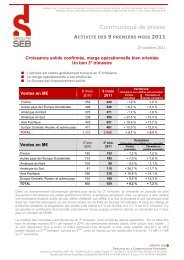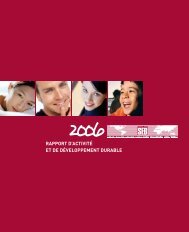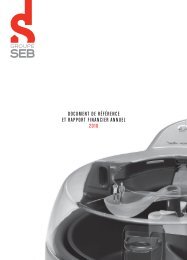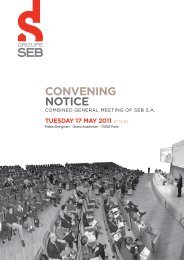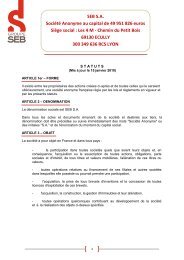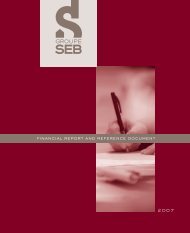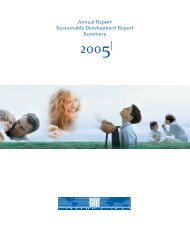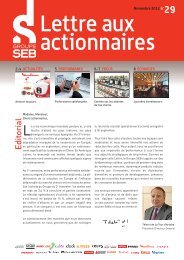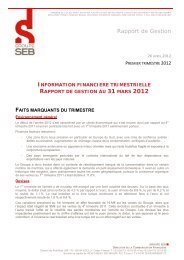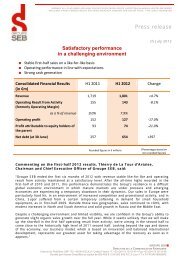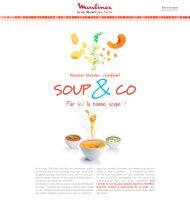financial report and registration document 2011 - Groupe SEB
financial report and registration document 2011 - Groupe SEB
financial report and registration document 2011 - Groupe SEB
You also want an ePaper? Increase the reach of your titles
YUMPU automatically turns print PDFs into web optimized ePapers that Google loves.
� €1 million in compensation costs incurred on the termination of contracts<br />
with external sales representatives in Argentina, where a similar decision<br />
was taken to insource sales forces;<br />
� a €1.7 million provision set aside in the Netherl<strong>and</strong>s for restructuring costs<br />
that will be incurred as part of the project to streamline the Group’s supply<br />
chain <strong>and</strong> after sales services in Western Europe.<br />
2010<br />
Restructuring costs for 2010 amounted to €15,0 million, mainly comprising:<br />
� an additional cost of €4.8 million recorded in France due to the pension<br />
reform that has extended the period during which the Group will incur<br />
expenses under the pre-retirement plans introduced at certain sites in<br />
2006;<br />
� €6.5 million in compensation costs incurred in Brazil on the termination<br />
of contracts with external sales representatives following the Group’s<br />
decision to insource all of its sales forces with the aim of improving<br />
customer service quality <strong>and</strong> controlling the entire value chain;<br />
� sales force rationalisation costs of €2.4 million in China, where responsibility<br />
for selling Tefal br<strong>and</strong> products was transferred to the Supor sales force.<br />
2009<br />
Restructuring costs for 2009 amounted to €41.3 million, mainly comprising:<br />
� €7.9 million in costs related to the redundancy plan at the Erbach site in<br />
Germany following the announcement on 11 February 2009 of a plan to<br />
reorganise the Group’s European iron manufacturing operations;<br />
� a total of €20.4 million in restructuring costs recorded in France due to:<br />
� the reorganisation of iron manufacturing sites which resulted in a preretirement<br />
plan at the Pont-Évêque site,<br />
� provisions booked following the decision to combine the R&D <strong>and</strong><br />
marketing teams from the La Defense <strong>and</strong> Caen sites at a facility in<br />
Burgundy to create a single, optimised “Electric Cooking Appliances” unit,<br />
� an additional provision booked as a result of the 2006 Vosges site closure;<br />
� a €5.8 million provision booked in Italy, where the Group announced job<br />
cuts in September 2009 at the Omegna site;<br />
� an aggregate €7.2 million in restructuring costs recorded in various other<br />
countries, where in light of the severe economic crisis the Group continued<br />
to realign the organisational structures for (i) its manufacturing facilities in<br />
Brazil <strong>and</strong> the United States, (ii) its administrative functions in Spain, <strong>and</strong><br />
(iii) its sales activities in Norway <strong>and</strong> the United Kingdom.<br />
Financial Report <strong>and</strong> Registration Document <strong>2011</strong><br />
5<br />
Consolidated fi nancial statements<br />
Notes to the consolidated fi nancial statements<br />
Note 6.2. IMPAIRMENT LOSSES<br />
<strong>2011</strong><br />
In application of the principle described in Note 1.4.3, certain manufacturing<br />
cash-generating units (CGUs) were tested for impairment by comparing the<br />
carrying amount of the assets of each CGU with their value in use. The value<br />
in use calculations were performed based on the sum of discounted future<br />
cash fl ows expected to be derived from the assets concerned as contained<br />
in the fi ve-year business plan as well as a terminal value determined by<br />
extrapolating the cash fl ows forecast for the last year of the plan. All CGUs<br />
comprising intangible assets with an indefi nite useful life were tested for<br />
impairment at the year-end <strong>and</strong> CGUs comprising assets with fi nite useful<br />
lives were only tested when there was an indication that they may have been<br />
impaired. The main impairment tests <strong>and</strong> CGUs concerned are discussed<br />
in Note 10 - Intangible Assets.<br />
The main impairment loss recognised in <strong>2011</strong> was an additional €7.2 million<br />
impairment of the All-Clad goodwill, in addition to the €37.7 million loss<br />
already recognized in 2010. The amount recognised in <strong>2011</strong> refl ects the fact<br />
that the business plan used as the basis for the impairment test carried out<br />
during the year factored in a fl at fi rst-half performance for All-Clad caused<br />
by the continuing lacklustre environment in the US premium sector. The fairly<br />
marked turnaround in All-Clad’s performance during the second half of the<br />
year – driven by the launch of new cookware ranges – was not suffi cient to<br />
fully offset this fi rst-half situation.<br />
The Group also recognised other, less signifi cant, impairment losses in <strong>2011</strong><br />
against goodwill relating to Greece <strong>and</strong> Vietnam, representing an overall<br />
amount of €3.2 million.<br />
In addition, a €3.1 million impairment loss was recorded to write down a<br />
portion of the manufacturing assets of the Omegna site in Italy.<br />
The main assumptions used in <strong>2011</strong> for impairment tests on the<br />
manufacturing CGUs in Europe were as follows:<br />
� the weighted average cost of capital was estimated at 8.49% (versus<br />
8.18% in 2010 <strong>and</strong> 8.66% in 2009);<br />
� the long-term growth rate beyond the fi ve-year period covered by the<br />
business plan was set between 0% <strong>and</strong> 2%, depending on the business<br />
of the CGU concerned (unchanged for the past three years).<br />
Broadly, the tests performed on the European manufacturing CGUs at end-<br />
<strong>2011</strong> showed little sensitivity to changes in the fi nancial assumptions used<br />
(WACC <strong>and</strong> long-term growth), thanks to satisfactory production volumes<br />
in <strong>2011</strong>.<br />
2010<br />
The main impairment loss recognised in <strong>2011</strong> was an additional write-down<br />
of the All-Clad goodwill for €14.7 million. After the deep recession in 2009,<br />
there was a signifi cant recovery in sales in 2010 but the general environment<br />
in the US premium segment remained hesitant <strong>and</strong> pre-recession margins<br />
were not restored by the year-end. These conditions were included in the<br />
business plan that serves as a basis for impairment testing, which led to the<br />
above-mentioned €14.7 million goodwill impairment loss in addition to the<br />
€21.2 million loss already recognised in 2009.<br />
GROUPE <strong>SEB</strong><br />
5<br />
97



